
Sixty years ago this month, Harvey Gantt became the first African American student to attend Clemson after the U.S. Fourth Circuit Court of Appeals ordered the University to admit him. Six decades later, Clemson continues to work toward growing the diversity of its student body and faculty and promoting the kind of environment where everyone can be a positive change agent. The University will celebrate the occasion with a series of events in January and February including:
- January 26, 416 Watt Family Innovation Center, 1 p.m.: Harvey Gantt’s Rise after Fall: The Integration of Clemson College. Lecture by Marquis Drayton, Community Engagement Assistant for the Woodland Cemetery at Clemson University. Drayton will digitally tell the story of Gantt’s legal battle to enter Clemson as its first minority student in 1963 using archival footage, campus maps, and YouTube visuals.
- January 27, Lee Art Gallery, 5 p.m.: Legacy: Celebrating the Impact of Harvey Gantt art exhibit opening with guest of honor Cecil Williams, a pioneering African American photographer, publisher, author and inventor best known for his photography documenting the civil rights movement in South Carolina beginning in the 1950s. The event will include short statements by the artists followed by informal conversations with faculty, students, alumni and community members. Exhibit will run through Feb. 14.
- January 28, R.M. Cooper Library, 6 p.m.: 60th Anniversary Gala — Celebrating the Anniversary of Integration at Clemson. Proceeds benefitting the Harvey Gantt Scholarship Endowment. Tickets can be purchased at this link.
- January 28 – 29, Brooks Center for the Performing Arts: “Call My Name, The Play”. A staged reading of three vignettes based on the groundbreaking research by Calhoun Lemon Professor of Literature Rhondda Thomas, created in collaboration with the Tectonic Theater Project, a New York-based company that develops new plays through a rigorous process of research and collaboration that is best known for producing the internationally renowned play “The Laramie Project.”
- January 30, Lee 111, 5 p.m.: Speaker Sekou Cooke; architect, urban designer, researcher and curator director of the Master of Urban Design program at UNC Charlotte. Born in Jamaica, Cooke is the 2021/2022 Nasir Jones HipHop Fellow at the Hutchins Center for African & African American Research at Harvard University, and a founding member of the Black Reconstruction Collective. Cooke is a leading advocate for the study and practice of hip-hop architecture, which addresses the broad impacts of the racist history of architecture and urban planning, opening a pathway for practice, education, and scholarship that embraces architecture as a tool for shaping, reflecting, and understanding culture.
- January 31, McKissick Theater, Hendrix Student Center, 6 p.m.: Screening of the film, “Carolina Stories: The Education of Harvey Gantt.”
- February 1, Lee 111, 5 p.m.: “Architects as Advocates.” Speaker Julian Owens, BA in Architecture ’16, Master of Architecture ’18. Owens class in Clemson’s School of Architecture, with more than 150 students, included only 10 Black students, a number that dwindled further by the time graduation approached. During his time at Clemson the campus saw acts of racism such as the distribution of Ku Klux Clan recruitment flyers and the vandalism of a banner celebrating architect, civil rights leader and the University’s first Black student, Harvey Gantt. Recognizing the need for a safe space for his colleagues, Owens founded Clemson’s National Organization of Minority Architecture (NOMA) chapter. Owen’s speech will be followed by a panel discussion with fellow Clemson architecture and design graduates.
- February 3, Lee 111, 5 p.m.: “Integration and Inclusion through the Decades,” a presentation by Mario Gooden ’90, professor of professional practice, Columbia University Graduate School of Architecture, Planning and Preservation, followed by a panel discussion with School of Architecture alumni representing the decades since Harvey Gantt’s integration of Clemson University.
- On-going Exhibits (January 26 – March 10, 2023):
- Separate But Not Equal: A Deep Dive into the Desegregation of Academia, Gunnin Architecture Library. Included in the display are books on civil rights, Supreme Court decisions and the history of racial segregation, particularly as it relates to southern academia.
- Harvey Gantt’s Journey to Clemson, Cooper Library 4th floor lobby exhibit cases. This exhibit uses documents and photographs from the Clemson University Libraries Special Collections and Archives to follow Harvey Gantt’s path through history on his way to January 28, 1963.
Gantt met his wife, Lucinda, at Clemson, graduated with honors in architecture, earned a master’s from MIT and became an influential leader in Charlotte, including serving two terms as mayor. He is the recipient of numerous lifetime achievement awards in public service, activism and social responsibility. In 2009, the Afro-American Cultural Center and the City of Charlotte honored Gantt by building the Harvey B. Gantt Center for African-American Arts + Culture, recognizing his contributions to the civil rights movement and as the city’s first black mayor.
For more information go to this link, or contact Sara Hanks at smitch5@clemson.edu.

